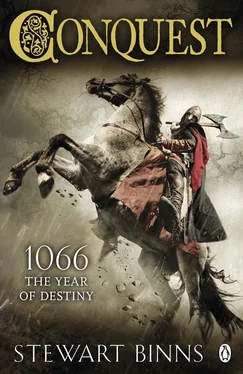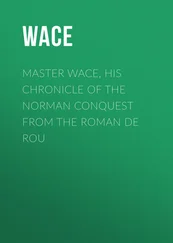Throughout the early summer of 1071, the Norman army gathered around Ely and William’s newly commissioned ships sailed into fenland waters.
The fleet consisted of standard longships carrying butescarls, smaller, flat-bottomed boats to navigate shallow waterways, and vessels adapted to carry catapults and ballisti. There was also a flotilla stationed in the Wash to act as supply ships and to prevent any naval ambush by Danish or Scottish allies of the Brotherhood.
On land, William ordered permanent camps to be prepared on the solid ground around the Isle of Ely and assembled a formidable show of strength. There were 4,000 infantry, 40 squadrons of cavalry, 500 archers and crossbowmen, and an array of blacksmiths, sappers and shipwrights. He had thought carefully about the assault; his planning, as always, was scrupulous. He intended to use catapults on any surrounding hillocks and islands that were within range of Ely and build tall towers for ballisti that could hurl stones, fire and boiling oil at the defenders. Finally, and most significantly, he intended to use pontoons to construct a new causeway for a final assault on the island.
When all the King’s forces were in position, the Brotherhood was heavily outnumbered. Just 3,000 defenders faced an amphibious Norman assault force of almost 8,000. Crucially, William was able to bring in more men, equipment and materiel to an all but limitless extent.
The first assault would come from ground to the south-east of the island. While archers and crossbowmen loosed hails of arrows, and catapults launched their projectiles on to the Isle, Norman sappers would build a new causeway to the island. It would be a floating pontoon to span a stretch of water almost 800 yards across. The causeway would have to fall short of the island by about 200 yards because of the threat from the arrows of the defenders, but William estimated that his horses could cope with the shallow water at that point and reach the island. When it was completed, William planned to mount a cavalry attack with infantry in support.
Hereward’s defence on the landfall side was a high peat bank and ditch. However, to prevent him massing too many defenders behind the bank, William planned simultaneous amphibious attacks all around the island, thinly stretching Hereward’s forces around Ely’s twenty-mile perimeter. Communications would be vital for the defenders, and Martin Lightfoot’s messengers would have one of the most difficult tasks.
When, several weeks later, the pontoon was ready, William’s first cavalry attack, early on a clear June morning, was heralded by a single arrow shot high into the sky. Dawn had brought an amber glow to the water and the distant clouds were framed by golden sunbursts. There was silence, the meres and waterways of the Fens still, but the calm was soon interrupted by the rumble of heavy cavalry. As the riders began to cross the causeway, three abreast in tight formation, their horses’ hooves clattering on the timber of the new bridge sent a chilling echo around the Isle.
The attack was a hopeless failure.
William had to put a large body of cavalry on to the causeway for the attack to have any momentum, but the structure appeared unable to support such a volume of men and horses, especially in the middle where it crossed the much deeper course of the River Cam. The pontoon began to give way after about 250 yards, and the charge lost its discipline. The lead horses panicked and, within minutes, hundreds of men and their steeds were floundering in the murky waters and deep mud.
Few got out alive.
William ordered his senior engineer to be executed on the spot and twenty of his sappers were flogged in front of the entire army.
Although the design of the pontoon was flawed, what William did not know was that its imperfections were significantly exacerbated by Hereward’s cunning. Night after night, Alphonso and Hereward and their squads of saboteurs had slipped into the cold waters of the Great Fen to partially sever the structure’s ropes and timbers beneath the waterline. Thanks to their handy work, the pontoon was doomed.
William rarely made mistakes, so to have made two in one day was unprecedented. Not only had he built an inadequate causeway, he had also failed to realize the significance of the day chosen for the attack. If he had owned an astrolabe, he would have known that it was the twenty-third day of June.
Hereward knew the date, because he had used his precious gift from Rodrigo of Bivar to calculate it. He had made plans for a religious service, followed by the roasting of an ox, because 23 June was the feast day of St Etheldreda, the virgin martyr of Ely and patron saint of the Brotherhood. When William belatedly heard of the coincidence, his fury knew no bounds. He dismissed his seers, sending them back to Normandy bound hand and foot and dressed as harlequins complete with foolscaps. He stormed around his camp in a drunken rage, berating everyone in sight.
William ordered a new, much more substantial causeway, to be built. It would begin opposite Aldreth, on the southern tip of the island at the furthest point from the Burgh of Ely. Norman soldiers were despatched far and wide to round up hundreds of English peasants to provide the forced labour to construct it. The new structure would be much longer, almost a mile, and would be solid and permanent. It would be based on piles formed by stone gabions, topped by sheepskins of sand and covered by heavy timbers of elm and oak.
Protected by towers and sentry posts and wide enough for cavalry six abreast, it would form an important part of the fortifications being built all over England to ensure that the kingdom remained under Norman rule for generations to come.
William would not repeat his earlier mistakes.
As July and August came and went, Hereward watched the new causeway grow. He knew that he needed to buy some extra time, to allow winter to come to the aid of the Brotherhood.
He organized raiding parties, large and small, all of which he led himself, to harass the Normans. Using small boats along the hidden waterways and streams of the Fens, he ambushed Norman patrols, burned their supplies and scattered their horses and livestock. On one of these punitive raids, Edwin, Earl of Mercia, was caught trying to cross a mere by a troop of Norman cavalry and cut down. His body was later recovered and, presided over by Bishop Aethelwine, he was given a funeral befitting an earl of England. His death meant that Morcar, Earl of Northumbria, became the last English earl not under the heel of the Normans.
In the middle of September, Hereward returned to Ely from a three-day raid on one of William’s supply camps on the road to Cambridge, to face disturbing news.
Bishop Aethelwine, Siward Bjorn, Earl Morcar and Martin Lightfoot came to see him with a report that, although morale remained high, Abbot Thurstan’s monks had been fomenting dissent within the Brotherhood. Earl Morcar had discovered that Thurstan was sending messages to William and that a deal had been done between them for the end of the siege.
In return for encouraging opposition within Ely, William would grant significant new lands to Thurstan and endow Ely Abbey with a considerable sum from his treasury at Winchester. Several monks were very tempted by this and, with Thurstan’s encouragement, had started a whispering campaign to spread doubt through the ranks. The monks were also talking seditiously to the townspeople, some of whom, especially the wealthier ones, had no real sympathy for the Brotherhood’s cause and would much prefer to trade with the wealthy Normans.
Hereward gave swift instructions to convene a court of fifty randomly-selected members of the Brotherhood in the cloisters of the abbey. Thurstan was summoned to appear before it. Earl Morcar presided and conducted an elaborate trial with witnesses and formal statements.
Читать дальше












